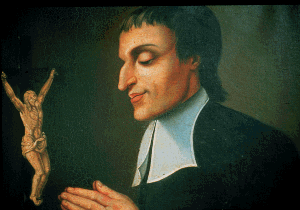Introvigne's debt to Plinio
Corrêa de Oliveira
by Miguel Martinez We have already seen how in the past Introvigne rarely wrote an article without taking a quote from Plinio Corrêa de Oliveira's Revolution and Counter-Revolution. In public, he rarely mentions the "Doctor" today. Plinio's influence however still appears in many ways. For example, in a footnote in an article ("Che cos'è il millenarismo", in Sette e religioni, Jan.-March 1991, p. 40), Introvigne suddenly engages in a violent polemic against other quite orthodox Catholic scholars who had expressed some doubts about an exceptionally fanatical and little known French preacher, Saint Louis Marie Grignion de Montfort (1673-1716). This French priest just happens to be - as we have seen - Plinio's favourite saint, who bases his entire book Revolution and Counter-Revolution on a rather dubious interpretation of his apocalyptic visions. As Plinio devoutly says,

Another example: although Introvigne generally writes rather clearly, his writings on the Solar Temple will probably seem incomprehensible to most people. Apart from the fact that he is quite obviously trying to protect every other cult from the fall-out, what is he talking about? Something about the Knights Templar and the Second Revolution (with capital letters) eating their own children… Actually the text is perfectly comprehensible to any reader who happens to have read Plinio's writings, but to no one else. Of course there are hundreds of cults (and other, quite innocent groups) with much the same Templar mythology and homeopathy mix as in the Solar Temple - it is only when they get on the bad side of the press that Introvigne tries to show they are something out of the French Revolution. This leads Introvigne to explain away the
Solar Temple while saving Moon, Scientology and the like:
We can see where Alleanza Cattolica picks up the term "socialcommunist"; the Second Revolution refers to the Enlightenment and to the French Revolution, the Fourth to modern "decadence". According to Introvigne's complicated expressions, the Solar Temple was the fault of Voltaire, Jonestown the fault of Karl Marx. Waco, on the other hand, was a "Christian holocaust", as Introvigne titled an article in Cristianità, June-July 1993. Introvigne's explanation of Jim Jones,
a regularly ordained Protestant pastor who set up a quite typical American
cult before leading his followers to their Jonestown doom, is much simpler:
they were Communists, and Communists do that sort of thing. Introvigne,
who claims that this event was the "extreme conclusion of a Marxist itinerary
carried to its most logical consequences", even speaks of "Soviet advisors"
at Jonestown - one wonders whether they were there to kill off their own
comrades, or to commit suicide themselves.
His earlier article Il suicidio della Guyana fra mito e storia (Cristianità, n. 162, October 1988) is typical of his method. Full of bibliographical footnotes, it looks quite convincing until one analyses its actual content. The first subtitle is quite explicit: "The 'anti-cult movement' and the myth of the 'suicide cult". He is clearly more interested in dealing a blow at his personal enemy than in analysing Jonestown. He first describes the "anti-cult movement" in the same terms that recur in every other work of his on cults, saying that the anti-cult movement believes that "cult brainwashing" [sic] led to the mass suicide in Guyana. He then goes on to demonstrate that Rev. Jones' group was actually Communist. Whether true or not, this proves nothing whatsoever. Introvigne is perfectly aware that the "anti-cult movement", as far as one can speak of a coherent set of ideas in such a mixed bag of organizations, holds that cults may be religious, commercial, therapeutical or political; that it is the deed and not the creed that matters. Introvigne is well aware of this, as he repeatedly criticises this notion elsewhere. Indeed a leading cult critic, Janja Lalich, writes on the basis of her experience in a Marxist-feminist group. The question posed by cult critics about Jonestown is entirely different: can a closed group, whatever its ideology, create such a conditioning atmosphere as to lead its followers to commit a mass suicide, or was the mass suicide simply a sum of nearly one thousand simultaneous free decisions taken by men, women and children? Introvigne's conclusion is no answer to
this vital question:
   |